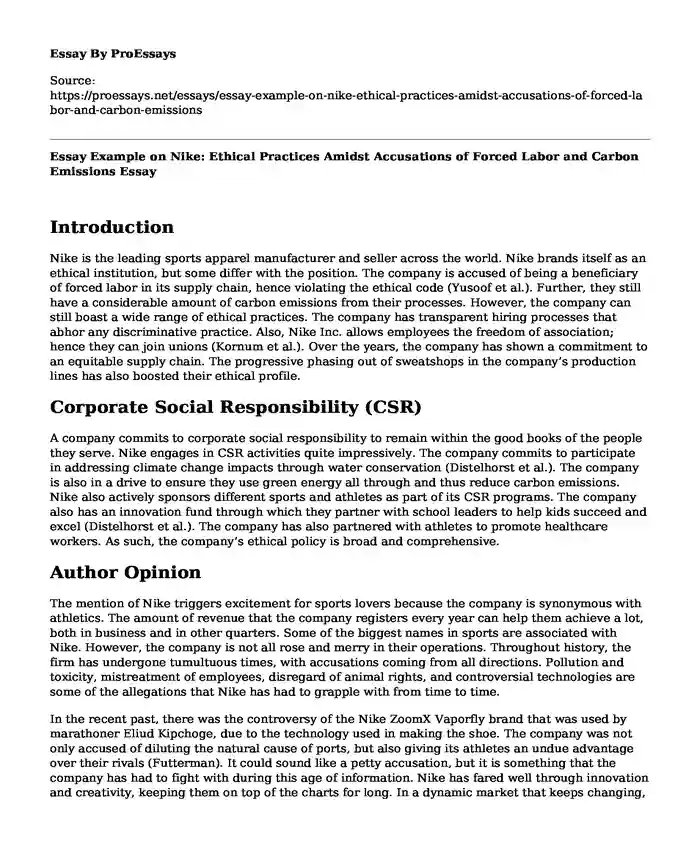Introduction
Nike is the leading sports apparel manufacturer and seller across the world. Nike brands itself as an ethical institution, but some differ with the position. The company is accused of being a beneficiary of forced labor in its supply chain, hence violating the ethical code (Yusoof et al.). Further, they still have a considerable amount of carbon emissions from their processes. However, the company can still boast a wide range of ethical practices. The company has transparent hiring processes that abhor any discriminative practice. Also, Nike Inc. allows employees the freedom of association; hence they can join unions (Kornum et al.). Over the years, the company has shown a commitment to an equitable supply chain. The progressive phasing out of sweatshops in the company’s production lines has also boosted their ethical profile.
Corporate Social Responsibility (CSR)
A company commits to corporate social responsibility to remain within the good books of the people they serve. Nike engages in CSR activities quite impressively. The company commits to participate in addressing climate change impacts through water conservation (Distelhorst et al.). The company is also in a drive to ensure they use green energy all through and thus reduce carbon emissions. Nike also actively sponsors different sports and athletes as part of its CSR programs. The company also has an innovation fund through which they partner with school leaders to help kids succeed and excel (Distelhorst et al.). The company has also partnered with athletes to promote healthcare workers. As such, the company’s ethical policy is broad and comprehensive.
Author Opinion
The mention of Nike triggers excitement for sports lovers because the company is synonymous with athletics. The amount of revenue that the company registers every year can help them achieve a lot, both in business and in other quarters. Some of the biggest names in sports are associated with Nike. However, the company is not all rose and merry in their operations. Throughout history, the firm has undergone tumultuous times, with accusations coming from all directions. Pollution and toxicity, mistreatment of employees, disregard of animal rights, and controversial technologies are some of the allegations that Nike has had to grapple with from time to time.
In the recent past, there was the controversy of the Nike ZoomX Vaporfly brand that was used by marathoner Eliud Kipchoge, due to the technology used in making the shoe. The company was not only accused of diluting the natural cause of ports, but also giving its athletes an undue advantage over their rivals (Futterman). It could sound like a petty accusation, but it is something that the company has had to fight with during this age of information. Nike has fared well through innovation and creativity, keeping them on top of the charts for long. In a dynamic market that keeps changing, Nike has positioned itself as the market leader; they design a path, and others follow. This way, they have managed to keep fierce competitors like Adidas at bay.
Conclusion
The success of Nike must have detractors, and they will always keep standing on the path of the company whenever there is a chance. Talk of a lack of ethics and morals shall always be there since there is no universal standard set for the same. People will always make that evaluation based on prevailing forces and circumstances. The founder of Nike, Phil Knight, felt that people who hate a brand do not matter; rather, the ones who love it are the ones who count. The company’s success today could have vindicated the founder’s sentiments. However, every institution must be careful of the steps it takes in the market to ensure continued progress. Despite the magnitude of a brand, unethical behavior and lack of corporate social responsibility could take it down crumbling.
Works Cited
Distelhorst, Greg et al. “Does Lean Improve Labor Standards? Management And Social Performance In The Nike Supply Chain”. Management Science, vol 63, no. 3, 2017, pp. 707-728. Institute For Operations Research And The Management Sciences (INFORMS), doi:10.1287/mnsc.2015.2369. Accessed 28 June 2020.
Futterman, Matthew. “Nike Vaporfly Shoes Avoid Olympics Ban.” Nytimes.Com, 2020, https://www.nytimes.com/2020/01/31/sports/olympics/nike-vaporfly-shoe-ban.html.
Kornum, Niels et al. “Interplay Between Intended Brand Identity And Identities In A Nike Related Brand Community: Co-Existing Synergies And Tensions In A Nested System.” Journal Of Business Research, vol 70, 2017, pp. 432-440. Elsevier BV, doi:10.1016/j.jbusres.2016.06.019. Accessed 28 June 2020.
Yusoof, Saifulbakri et al. Wages Of Labour Discrimination: Case Study On Nike Company Indonesia. 2017, http://dx.doi.org/10.6007/IJARPPG/v4-i1/2546. Accessed 28 June 2020.
Cite this page
Essay Example on Nike: Ethical Practices Amidst Accusations of Forced Labor and Carbon Emissions. (2023, Sep 19). Retrieved from https://proessays.net/essays/essay-example-on-nike-ethical-practices-amidst-accusations-of-forced-labor-and-carbon-emissions
If you are the original author of this essay and no longer wish to have it published on the ProEssays website, please click below to request its removal:
- Research Paper on Engaging Parents With Children
- Essay Sample on Nudging
- Personal Identity and Communication Essay Example
- Essay Sample on Maintaining Professional Relationship for Counseling: Ethical & Cultural Factors
- Essay Example on Fear & Loathing: Reflection of Society in Dramatic Literature
- Essay Example on Exciting IT Careers: Exploring Opportunities in the Field
- Paper Example on Job Diversity: A Key to Unifying Relationships in the Workplace







